Pecorino Romano is a hard Italian cheese made with sheep’s milk. It is mostly used for grating over other foods as the hard, crumbly cheese has a distinctive saltiness that works well in many dishes. If you’re looking for a pecorino romano substitute, read on to find out some excellent alternatives you can use for any situation.
Contents:
What Is Pecorino Romano?
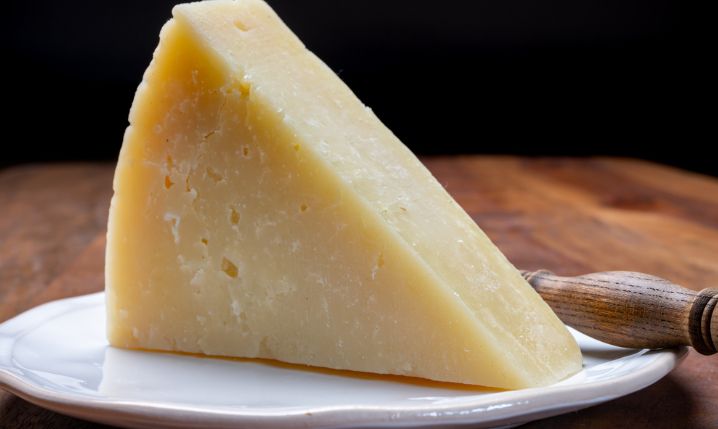
Pecorino Romano is an Italian hard-cheese made from pasteurized or unpasteurized sheep’s milk. It’s primarily used in Central and Southern Italy, notably Lazio, Sardinia, and Tuscany.
The cheese is aged for five months or more with a hard and crumbly texture. It has a famous salty flavor and is often used in place of salt for many recipes and dishes. As pecorino romano is a hard cheese, it is mostly grated and sprinkled over food rather than sliced or melted.
Pecorino Romano is typically a pale yellow color in appearance, with a natural rind with a color that varies from brown to black. It has a salty, smokey flavor with a slightly sharp taste. The texture is extremely crumbly and flaky.
You can use pecorino romano for mixing into or sprinkling over carbonara, pesto, pizza, pasta, salads, and more.
Substitutes For Pecorino Romano
No matter the reason or recipe you require a substitution for pecorino romano, we’ll explore several excellent options in detail below.
| Substitute | Taste | Good For |
|---|---|---|
| Romano | Mild, Tangy, Sharp | Salads, Pasta, Pesto |
| Parmigiano Reggiano | Nutty, Savory, Mildly salty | Pasta, Soufflés, Sauces |
| Asiago | Milky, Mild, Sharp, Nutty | Pizza, Pasta, Bread |
| Grana Padano | Delicate, Fruity, Sweet | Pasta, Pizza, Cheese Boards |
1. Romano
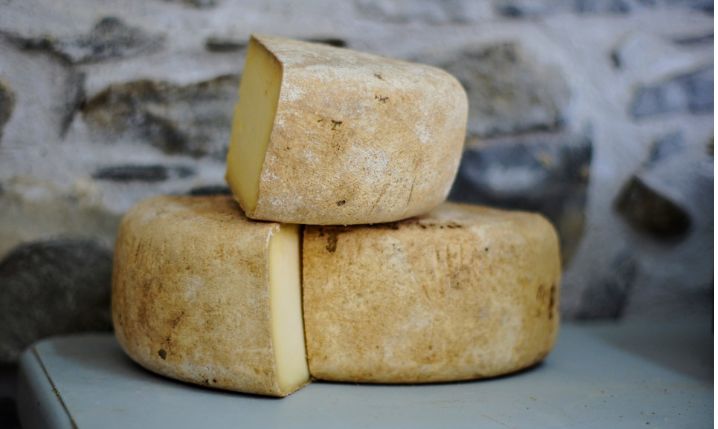
Romano cheese isn’t as similar to pecorino romano as the name suggests. For one thing, romano cheese comes from the Parmesan family, whereas pecorino romano comes from the pecorino cheese family.
In addition to that, romano cheese is made from cow’s, goat’s, and sheep’s milk, while pecorino romano is only made from sheep’s milk.
That being said, it does make an excellent substitute as they are visually very similar cheeses, both having the same pale yellow color.
In terms of texture, it is a good substitute because romano is a dense, hard cheese that crumbles and flakes well. This means you can use it for thin slices in salads or for grating over pasta dishes.
The main overall difference is the flavor because romano cheese doesn’t have the same intense saltiness you get with pecorino romano. Instead, it has a mild salty taste but still has the same sharp, tangy flavors.
You can use pecorino romano and romano cheese as a 1:1 substitute for one another.
2. Parmesan (Parmigiano Reggiano)
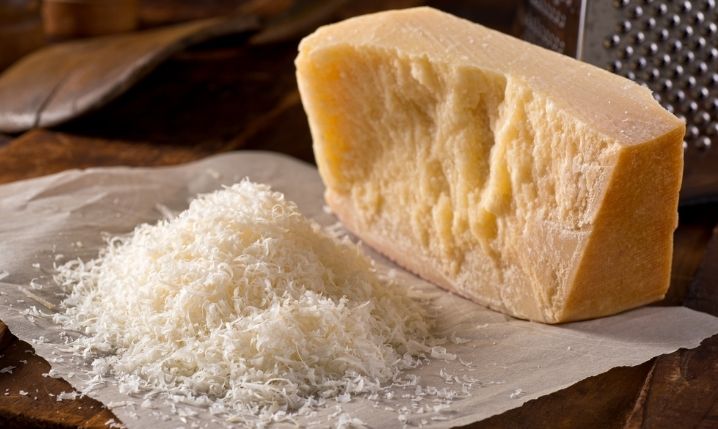
Parmigiano Reggiano, also known as Parmesan, is one of the best alternatives to pecorino romano as it is so widely available for purchase in stores. You can often find it pre-grated because it’s most often used for sprinkling over cooked foods such as sauces, pasta, and similar.
Parmesan has a dense and grainy texture. Similar to pecorino romano, it’s a hard artisanal cheese. The color is richer, with a darker yellow more reminiscent of straw. In terms of taste, it has a more savory nutty flavor than pecorino romano does, it’s still got a distinct saltiness, but it’s not quite as intense.
Another big difference between the two, which accounts for some of the difference in flavor, is that parmesan is made from cow’s milk, not sheep’s milk like pecorino romano.
You can use Parmigiano Reggiano as a 1:1 substitute for pecorino romano in pasta dishes such as Cacio e Pepe and more.
3. Asiago
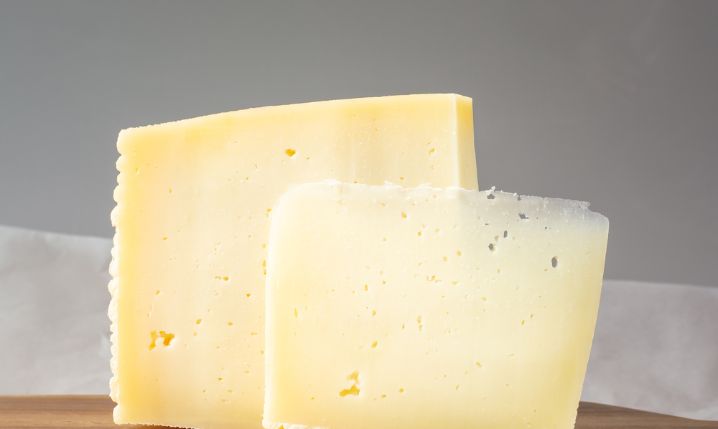
Asiago is another hard Italian cheese that is often shaved and added to salad dishes or for grating and sprinkling over various sauces or pasta dishes.
It has a yellow color with a natural rind. The texture is smooth but crumbly with a pungent aroma.
As it’s made from cow’s milk, it has a different overall taste to pecorino romano, with a more full-flavored milky flavor. Overall, it’s a mild-sharp cheese that works well in many dishes.
When substituted for pecorino romano, it works best for melting on top of pizza, bread, and pasta dishes.
Asiago comes in multiple varieties depending on the age of the cheese. You should look to purchase a more mature asiago cheese that has been aged for at least ten months as it has a nuttier, saltier flavor that’s more reminiscent of both parmesan and pecorino romano.
4. Grana Padano
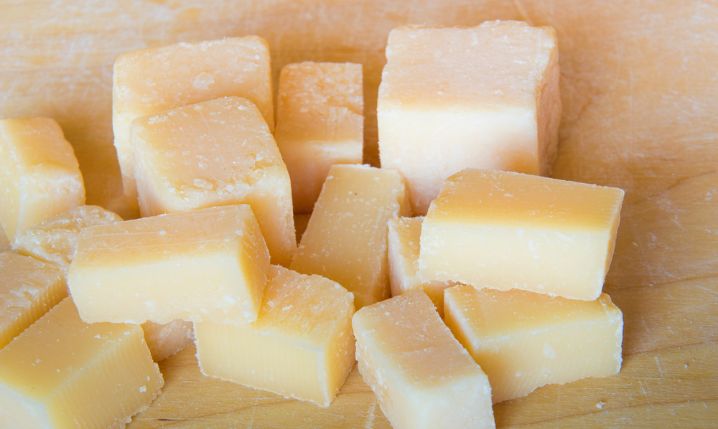
Grana Padano is another cow’s milk-based cheese from Italy. As with other options on this list, it comes from the parmesan family of cheeses and is a hard cheese.
With a pale yellow color, it’s perhaps the closest in overall appearance to pecorino romano. However, it’s the flavor that’s most different because grana padano has an overall delicate, fruity flavor that makes it less of an ideal substitute than some of the other options on this list.
Grana Padano is also aged for less time than many of the cheese options on this list, making it less sharp and salty than other alternatives.
You should also be aware that it’s not the easiest cheese to come across in the store, making it less widely available than other options such as parmigiano reggiano.
That said, it makes an excellent alternative in a pinch or when you’re looking for a new take on an old recipe.
You can use grana padano as a 1:1 substitution for pecorino romano in salads, pasta, cheese boards, and it can also be used as a general melting cheese.
Conclusion
In this article, we explored the best alternative cheeses you can use as a pecorino romano substitute. You can use parmesan for many dishes as it’s widely available, but there are equally other great options such as grana padano. Whatever you choose, it will work amazingly well in your next dish.
More about Pecorino Romano: